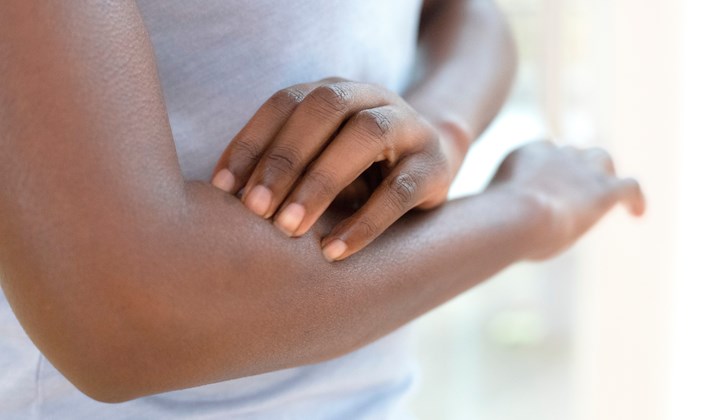
Pharmacy Services
Buy from your local pharmacy
Nearby Locations
What is Eczema and how is it treated?
Itching, dry skin, and rash. These are the most common symptoms of eczema, which affects both children and adults. In this article, you'll find out what exactly eczema is, what causes it, where on the body it is most commonly found and how it is treated.

What is Eczema?
Eczema is a non-infectious inflammatory disease of the skin. Eczema can affect anyone at any age, and symptoms usually start to appear in childhood and often persist into adulthood.
There are several types of eczema, and each has different triggers. The most common types of eczema are atopic eczema or atopic dermatitis, contact dermatitis, or seborrheic dermatitis.
How does Eczema manifest itself?
The most common symptoms of eczema include severe itching, redness, dry skin, scaly rashes, and festering. Bumps on the skin or swelling may also occur.
An eczema rash can take a slightly different form for each person. In people with dark skin tones, eczema causes purple, grey, or brown discolourations. In the case of people with light skin tones, it tends to be pink, red, or purple.
What causes Eczema?
There are several factors that cause eczema. Very often, an overreaction of the immune system to harmless irritants or allergens in the environment is to blame. Emotional triggers, such as high levels of stress or anxiety, or an environment that contains a large number of irritants, can also cause eczema symptoms to flare up. People with a family history of eczema are more likely to develop eczema.
Where can eczema occur?
Eczema can occur anywhere on the skin. However, parts of the body that are most prone to eczema include the face, palms of the hands, elbows, ankles, knees, feet, ears, and lips. Less commonly, eczema appears on the breasts and in the groin or on the foreskin.

Eczema on the face
Because eczema most often appears on parts of the body that are less protected by the skin barrier, many people struggle with the appearance of eczema in the face and neck area. Babies and toddlers are most prone to eczema rash on the face.
Eczema on the face can be very distressing, both physically and mentally. Ointments and eczema creams with corticosteroids are usually used to treat eczema in the facial area.
Eczema on the hands
Another place where eczema often appears is the hands. In the case of eczema, the skin on the hands is red, dry, itchy, and may even crack, and the symptoms are usually worse in winter.
Although these symptoms are indicative of atopic eczema, eczema on the hands is not always atopic and the causes, as well as the treatment, may vary. In many cases, severe eczema on the hands also occurs after contact with chemicals or certain plants, for example, in which case it is known as contact dermatitis. The so-called dyshidrotic eczema on the hands can also be to blame.
How is Eczema treated?
The treatment of eczema depends on what type of eczema it is, where it is located on the body and what causes the symptoms to flare up. In general, it is necessary to use the medication prescribed by your dermatologist, as well as pay attention to daily skin care routine and preventive measures.
In order to treat eczema as effectively as possible, it is important to identify what is behind the flare-up of symptoms and avoid these triggers. Also focus on eating a balanced diet and getting enough rest.
Medical treatment for eczema can include special eczema creams, anti-inflammatory medications, antihistamines that reduce the itching, or corticosteroids. Light therapy, also known as phototherapy, is also effective, as it improves the appearance of the skin and helps to remove skin patches caused by eczema.
How to choose the right type of Eczema cream?
A very important part of treating eczema, in addition to taking prescription medication, is to take regular care of your skin by lubricating it with a moisturizer. How to choose the right cream for eczema treatment?
In the pharmacy, you can buy facial, body or hand eczema creams that reduce the itching and moisturize the dry skin. It should always be hypoallergenic, fragrance-free, and dye-free. It should be gentle and suitable for sensitive. Last but not least, it should not contain preservatives or stabilizers that could aggravate the skin condition.
References
- https://acaai.org/allergies/allergic-conditions/skin-allergy/eczema/
- https://www.mayoclinic.org/diseases-conditions/atopic-dermatitis-eczema/symptoms-causes/syc-20353273
- https://my.clevelandclinic.org/health/diseases/9998-eczema
- https://www.drmax.cz/clanky/atopicky-ekzem-priciny-priznaky-a-lecba
- https://www.epaderm.cz/atopicky-ekzem/atopicky-ekzem-v-obliceji
- https://www.tetadrogerie.cz/clanky/krasa/oblicej/ekzem-v-obliceji-jak-se-ho-zbavit
- https://www.bepanthen.cz/co-mohu-delat-s-ekzemem-na-obliceji/
- https://www.prozeny.cz/clanek/ekzem-na-rukou-nemusi-byt-jen-atopicky-co-vsechno-jej-muze-zpusobit-a-kdy-vyhledat-lekarskou-pomoc-79665
- https://www.bioderma-cz.com/vase-pokozka/sucha-az-atopicka-pokozka/podrazdena-svediva-atopicka-pokozka/atopicky-ekzem-na-rukou-nohach-jak-je-osetrovat


